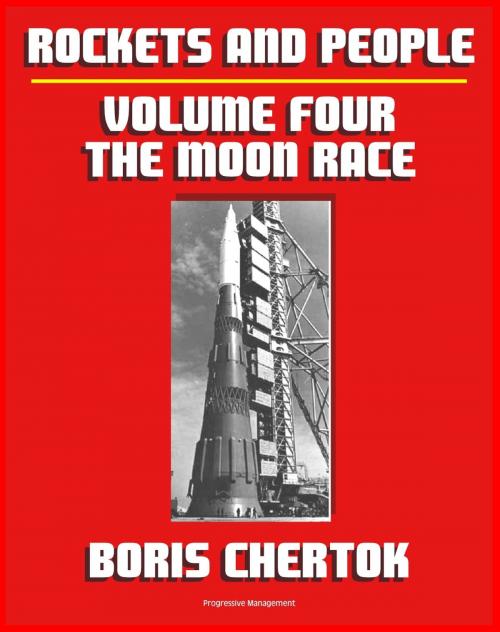Rockets and People: Volume IV: The Moon Race, the N-1 Moon Rocket, Salyut Space Stations, Soyuz 11 Tragedy, Energiya-Buran Space Shuttle, plus Bonus 1967 American Report on Soviet Program
Nonfiction, Science & Nature, Science, Physics, Astrophysics & Space Science, History, Asian, Russia| Author: | Progressive Management | ISBN: | 9781465891808 |
| Publisher: | Progressive Management | Publication: | February 7, 2012 |
| Imprint: | Smashwords Edition | Language: | English |
| Author: | Progressive Management |
| ISBN: | 9781465891808 |
| Publisher: | Progressive Management |
| Publication: | February 7, 2012 |
| Imprint: | Smashwords Edition |
| Language: | English |
In this fourth and final volume of the series, Boris Chertok concludes his monumental trek through a nearly 100-year life, providing fascinating insights into the Soviet moon landing program and the four failed launches of its giant N-1 moon rocket. He also provides new details about the Soyuz 11 depressurization accident which killed three cosmonauts, the Almaz and Salyut space stations, and the Energiya-Buran Space Shuttle.
This official NASA history series document has been converted for accurate flowing-text e-book format reproduction. As a bonus, we've included the historic American Congressional report on the Soviet space program from 1967 authored by the noted space historian Dr. Charles S. Sheldon II, Review of the Soviet Space Program 1967 with Comparative United States Data.
Contents: Chapter 1 * Rocket-Space Chronology (Historical Overview) * Chapter 2 * U.S. Lunar Program * Chapter 3 * N1-L3 Lunar Program Under Korolev * Chapter 4 * A Difficult Conversation with Korolev * Chapter 5 * N1-L3 Control * Chapter 6 * We're Behind, but We're Not Giving In * Chapter 7 * KORD and ATG * Chapter 8 * Once Again We're Ahead of the Whole World * Chapter 9 * "Sort It Out, and Report on Your Endeavors" * Chapter 10 * 1969 — the First N-1 Launch * Chapter 11 * After the Failure of N-1s No. 3 and No. 5 * Chapter 12 * Long-Duration Space Stations Instead of the Moon * Chapter 13 * Preparing for the Launch of DOS * Chapter 14 * Launching Salyut * Chapter 15 * Sun City * Chapter 16 * The Hot Summer of 1971 * Chapter 17 * The Last N-1 Launch * Chapter 18 * People in the Control Loop * Chapter 19 * Valentin Glushko, N-1, and NPO Energiya * Bonus - Review of the Soviet Space Program 1967.
Editor Asif Sidiqi notes: ”Having known both Korolev and Glushko, Chertok has much to say about the relationship between the two giants of the Soviet space program. Contrary to much innuendo that their relationship was marred by the experience of the Great Terror in the late 1930s, Chertok shows that they enjoyed a collegial and friendly rapport well into the 1950s. Chertok has much to say about the development of the so-called KORD system, designed to control and synchronize the operation of the 42 engines on the first three changes of the giant rocket (see Chapters 5 and 7, especially). One of the main challenges of developing the N-1's engines was the decision to forego integrated ground testing of the first stage, a critical lapse in judgment that could have saved the engineers from the many launch accidents. Chertok's descriptions of the four launches of the N-1 (two in 1969, one in 1971, and one in 1972) are superb. He delves into great technical detail but also brings into relief all the human emotions of the thousands of engineers, managers, and servicemen and women involved in these massive undertakings. His accounts are particularly valuable for giving details of the process of investigations into the disasters, thus providing a unique perspective into how the technical frequently intersected with the political and the personal. His account in Chapter 17 of the investigation into the last N-1 failure in 1972 confirms that the process was fractured by factional politics, one side representing the makers of the rocket (the Mishin design bureau) and other representing the engine makers (the Kuznetsov design bureau)."
In this fourth and final volume of the series, Boris Chertok concludes his monumental trek through a nearly 100-year life, providing fascinating insights into the Soviet moon landing program and the four failed launches of its giant N-1 moon rocket. He also provides new details about the Soyuz 11 depressurization accident which killed three cosmonauts, the Almaz and Salyut space stations, and the Energiya-Buran Space Shuttle.
This official NASA history series document has been converted for accurate flowing-text e-book format reproduction. As a bonus, we've included the historic American Congressional report on the Soviet space program from 1967 authored by the noted space historian Dr. Charles S. Sheldon II, Review of the Soviet Space Program 1967 with Comparative United States Data.
Contents: Chapter 1 * Rocket-Space Chronology (Historical Overview) * Chapter 2 * U.S. Lunar Program * Chapter 3 * N1-L3 Lunar Program Under Korolev * Chapter 4 * A Difficult Conversation with Korolev * Chapter 5 * N1-L3 Control * Chapter 6 * We're Behind, but We're Not Giving In * Chapter 7 * KORD and ATG * Chapter 8 * Once Again We're Ahead of the Whole World * Chapter 9 * "Sort It Out, and Report on Your Endeavors" * Chapter 10 * 1969 — the First N-1 Launch * Chapter 11 * After the Failure of N-1s No. 3 and No. 5 * Chapter 12 * Long-Duration Space Stations Instead of the Moon * Chapter 13 * Preparing for the Launch of DOS * Chapter 14 * Launching Salyut * Chapter 15 * Sun City * Chapter 16 * The Hot Summer of 1971 * Chapter 17 * The Last N-1 Launch * Chapter 18 * People in the Control Loop * Chapter 19 * Valentin Glushko, N-1, and NPO Energiya * Bonus - Review of the Soviet Space Program 1967.
Editor Asif Sidiqi notes: ”Having known both Korolev and Glushko, Chertok has much to say about the relationship between the two giants of the Soviet space program. Contrary to much innuendo that their relationship was marred by the experience of the Great Terror in the late 1930s, Chertok shows that they enjoyed a collegial and friendly rapport well into the 1950s. Chertok has much to say about the development of the so-called KORD system, designed to control and synchronize the operation of the 42 engines on the first three changes of the giant rocket (see Chapters 5 and 7, especially). One of the main challenges of developing the N-1's engines was the decision to forego integrated ground testing of the first stage, a critical lapse in judgment that could have saved the engineers from the many launch accidents. Chertok's descriptions of the four launches of the N-1 (two in 1969, one in 1971, and one in 1972) are superb. He delves into great technical detail but also brings into relief all the human emotions of the thousands of engineers, managers, and servicemen and women involved in these massive undertakings. His accounts are particularly valuable for giving details of the process of investigations into the disasters, thus providing a unique perspective into how the technical frequently intersected with the political and the personal. His account in Chapter 17 of the investigation into the last N-1 failure in 1972 confirms that the process was fractured by factional politics, one side representing the makers of the rocket (the Mishin design bureau) and other representing the engine makers (the Kuznetsov design bureau)."















